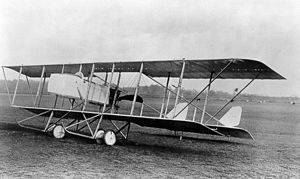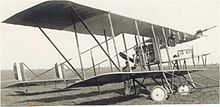Farman MF.11
| Farman MF.11 | |
|---|---|

| |
| Role | Reconnaissance / Bomber |
| Manufacturer | Farman Aviation Works |
| Designer | Maurice Farman |
| First flight | 1913 |
| Introduction | May 1914 |
| Primary users | French Air Force
Royal Flying Corps |
The Maurice Farman MF.11 Shorthorn is a French aircraft developed before World War I by the Farman Aviation Works. It was used as a reconnaissance and light bomber during the early part of World War I, later being relegated to training duties.
The Maurice Farman Shorthorn was the aircraft in which
Design and development
A pusher configuration unequal-span biplane like the earlier Farman MF.7, the MF.11 differed in lacking the forward-mounted elevator, the replacement of the biplane horizontal tail surfaces with a single surface with a pair of rudders mounted above it, and the mounting of the nacelle containing crew and engine in the gap between the two wings. The aircraft was also fitted with a machine gun for the observer, whose position was changed from the rear seat to the front in order to give a clear field of fire.
Its nickname in British service was derived from that of the MF.7 Longhorn, as it lacked the characteristic front-mounted elevator and elongated skids of its predecessor.
Operational history


On 6 September 1914 the first air-sea battle took place when a Japanese Farman MF.11 aircraft launched by the
The MF.11 served in both the British and French air services on the Western Front in the early stages of the war. It flew the first bombing raid of the war when on 21 December 1914 an MF.11 of the Royal Naval Air Service attacked German artillery positions around Ostend, Belgium.
The MF.11 was withdrawn from front-line service on the Western Front in 1915, but continued to be used by the French in Macedonia and the Middle East, while the British also used it in the Dardanelles, and Africa. The Australian Flying Corps (AFC), provided with the MF.11 by the British Indian Army, operated it during the Mesopotamian campaign of 1915–16.
Italy's
In 1916, the AFC also bought some MF.11s for training purposes.
Operators
- Australian Flying Corps
- No. 5 (Training) Squadron AFC in United Kingdom
- Mesopotamian Half Flight
- Central Flying School AFC at Point Cook, Victoria
- Belgian Air Force
- French Air Force
- Hejaz Air Force - Two Farman MF.11s were obtained from Italy in 1921.
- Imperial Russian Air Force
- Serbian Air Force
- Spanish Air Force
- Ukrainian Air Force - One aircraft only.

Surviving aircraft
- The
- Farman F.11A-2, Royal Army and Military History Museum, Brussels, Belgium.
- Farman MF.11 Shorthorn (#CFS-15), RAAF Museum at Point Cook, Victoria, Australia.[4]
Specifications (Farman MF.11)
Data from Encyclopedia of Military Aircraft[5]
General characteristics
- Crew: 2 (pilot & observer/gunner)
- Length: 9.45 m (31 ft 0 in)
- Wingspan: 16.15 m (53 ft 0 in)
- Height: 3.18 m (10 ft 5 in)
- Wing area: 57 m2 (610 sq ft)
- Empty weight: 550 kg (1,213 lb)
- Gross weight: 928 kg (2,046 lb)
- Powerplant: 1 × Renault 8D V-8 air-cooled piston engine, 75 kW (101 hp)
- Propellers: 4-bladed fixed-pitch pusher propeller
Performance
- Maximum speed: 106 km/h (66 mph, 57 kn)
- Endurance: 3 hours 45 minutes
- Service ceiling: 3,800 m (12,500 ft)
- Wing loading: 16 kg/m2 (3.3 lb/sq ft)
Armament
- Guns: 1 × 7.62 mm (0.30 in) machine gun
- Bombs: 18 × 7.3 kg (16 lb) bombs
See also
Related development
Related lists
- List of military aircraft of France
- List of pusher aircraft by configuration
- List of World War I Entente aircraft
References
- ^ Donko, Wilhelm M.: „Österreichs Kriegsmarine in Fernost: Alle Fahrten von Schiffen der k.(u.)k. Kriegsmarine nach Ostasien, Australien und Ozeanien von 1820 bis 1914“ (epubli, Berlin, 2013) - Page 4, 156-162, 427.
- ISBN 0-517-69186-8
- ^ "Maurice Farman S.11 Shorthorn". Canada Aviation and Space Museum. Retrieved 9 March 2024.
- ^ "Maurice Farman Shorthorn CFS-20". RAAF Museum Point Cook. Archived from the original on 4 January 2018. Retrieved 9 March 2024.
- ISBN 0-7525-8130-9
Bibliography
- Cony, Christophe (July 1997). "Aviateur d'Observation en 14/18 (deuxième partie)" [Observation Aircraft of 14/18]. Avions: Toute l'aéronautique et son histoire (in French) (52): 10–15. ISSN 1243-8650.
- Liron, Jean (1984). Les avions Farman. Collection Docavia. Vol. 21. Paris: Éditions Larivière. OCLC 37146471.
